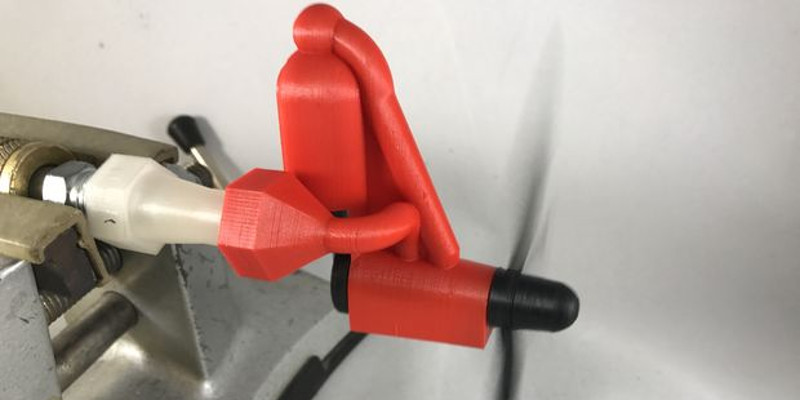One of the most important considerations when flying remote-controlled airplanes is weight. Especially if the airplane has a motor, this has a huge potential impact on weight. For this reason, [gzumwalt] embarked on his own self-imposed challenge to build an engine with the smallest weight and the lowest parts count possible, and came away with a 25-gram, 8-part engine.
The engine is based around a single piston and runs on compressed air. The reduced parts count is a result of using the propeller axle as a key component in the engine itself. There are flat surfaces on the engine end of the axle which allow it to act as a valve and control its own timing. [gzumwalt] notes that this particular engine was more of a thought experiment and might not actually produce enough thrust to run an airplane, but that it certainly will spark up some conversations among RC enthusiasts.
The build is also one of the first designs in what [gzumwalt] hopes will be a series of ever-improving engine designs. Perhaps he should join forces with this other air-powered design that we’ve just recently featured. Who else is working on air-powered planes? Who knew that this was a thing?
















Thermoacoustic engine. It’s a very strange stirling variant that, in principle, requires only one moving part (the piston), and the tolerances are so generous that you can literally make it out of scraps and trash and it will probably run. I think someone got a [HaD] article put up about theirs a while back — it was made out of a test tube, some steel wool, and a few other bits and bobs and it worked quite nicely…
The only catch is, unlike other stirlings, thermoacoustic engines are not self-starting.
Definitely lighter than one made from mill or lathe.
I CHALLENGE this comment, given a a few days and some delrin i guarantee i can get below 15 grams
Yes, this is interesting. Great inspiring article in an area of opportunity. Looking forward to improvements.
I was wondering if something like a Jet-X engine propellant can be used to power. Though this thought is more like using something that would gas off nitrogen slower in the explosive/combustion process. I was thinking this from an airbag design controlled and exhausted through the engine. This type systems would have to be metal printed though. I wonder if you could have a cartridge of primers since off the shelf and somehow load and fire for propulsion too.
With the air powered, I think using the air power rifles tanks can be an interesting way to save on fuel expense and be environmentally friendly.
If you’re going to use rocket fuel and explosives you might as well just make a rocket plane like the Me 163 or one of those model rockets that drops a glider at apogee.
For air powered just use a bike pump like the original designs. You can reach 100psi easily. They make foot pumps that go up to a couple hundred psi and air gun pumps that will handle 1000-2000psi, if you don’t mind the tendonitis.
There’s also probably no throttling system, which would make it a painr for a lot of modern RC plane designs (most are designed for a throttle-able BLDC motor these days). They’d probably still fly but would be a royal pain to learn the characteristics of with no ability to slow down ever. Instead of an ESC I guess it would use the standalone BEC from a glider?
Why not vary the prop pitch to control thrust?
interesting, but I recon that the speed will go up when the pitch of the blades change to a “less power” position. And when the speed goes up, the blades deliver more power, ending up when you started in the first place, but most likely with a lower efficiency. As a simple (but genius) motor like above doesn’t have any speed regulation (like a governor of some kind). The power output is directly regulated by the pressure.
We musn’t forget that this engine is not a replacement for all modern stuff, it is an engineering challenge. And a pretty interesting one.
Very nice project!
It probably would make a very good ascent motor for some sort of glider is what I’m thinking.
T he engine may be light as a feather, the compressed air tank? Not so much
This is inspired by the AirHogz gliders. The compressed air tank is essentially soda bottle pumped by a small hand pump. For the pressures here they’re more than sufficient, as well as light weight.
Dumb hardware question from a software guy–I would assume a compressed-air engine that drives a propeller would be less efficient for thrust than an air jet nozzle. Would love an “aerodynamics of propulsion” comparison of the two.
Thanks for the article on this design!
This is the first in a series of engines I’ve designed to use small co2 cartridges as the fuel source. The goal of this design was light weight, fewest parts, and 100% 3d printed (e.g. no screws, o-rings, ball bearings, etc.). This design did fly, but not as much power was produced as I desired due primarily to gas losses. I liked this design due to the ability to precisely control the timing of gas into the cylinder with no additional timing components.
Many thanks again for the article, I am truly honored! More to come…
Greg